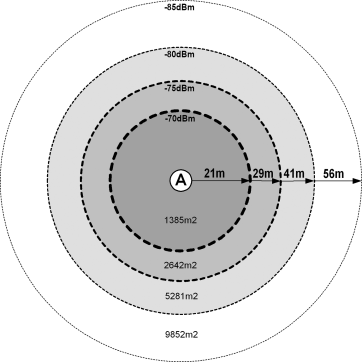5.4 Indoor Design Strategy
When all the measurement results have been analyzed and link budget calculations have been completed, you still need to place the antennas in the building. It is one thing to calculate the antenna service radius (see Figure 5.21) and the antenna overlap, but how do you actually use this information to implement the final design?
Figure 5.21 Indoor coverage radius and area vs design level from omni antenna

5.4.1 Hot-spot Planning Inside Buildings
The term ‘hot-spot’ is often used when planning the macro layer. A ‘hot-spot’ is a place of high traffic density of mobile users, needing special attention in terms of coverage, quality, capacity and data rates.
Hot-spots also exist inside buildings and, like in the macro network, these hot-spots can produce the major portion of the traffic in the cell. Indoor hot-spots will typically be areas where users sit down and work using their PC and mobile for an extended time. Most high-speed mobiles are actually data cards in PCs, so naturally the user will use a convenient sitting area where he can work in relative quietness. Examples of indoor hot-spots with high traffic density and high requirements for data speed performance could be business lounges in an airport, the food court in a shopping mall, the press area in a sports arena, the conference area at a hotel and executive and meeting areas in a corporate building. ...
Get Indoor Radio Planning: A Practical Guide for GSM, DCS, UMTS, HSPA and LTE, Second Edition now with the O’Reilly learning platform.
O’Reilly members experience books, live events, courses curated by job role, and more from O’Reilly and nearly 200 top publishers.

